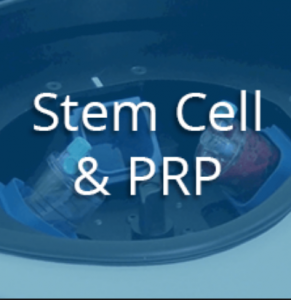Everything You Ever Wanted to Know About Stem Cell & PRP Therapy
Here at our Dayton cosmetic surgery practice, we are privileged to see a variety of  patients, such as those needing vein therapy and, recently, those considering stem cell injections as a treatment for arthritis and other degenerative joint problems instead of undergoing joint replacement. Both Stem Cell Therapy and PRP (Platelet Rich Plasma) have been used to decrease inflammation and create new tissue. Where they differ is that stem cells provide cells that become the damaged cell type; PRP stabilizes and repairs the cells that are present.
patients, such as those needing vein therapy and, recently, those considering stem cell injections as a treatment for arthritis and other degenerative joint problems instead of undergoing joint replacement. Both Stem Cell Therapy and PRP (Platelet Rich Plasma) have been used to decrease inflammation and create new tissue. Where they differ is that stem cells provide cells that become the damaged cell type; PRP stabilizes and repairs the cells that are present.
It’s easy to confuse PRP (Platelet Rich Plasma) injections with Stem Cell Therapy because they both use a patient’s own cells. As a baseline, stem cells come from fat or bone marrow; PRP comes from blood. Both are used to decrease inflammation and create new tissue.
To help you understand more about these new technologies, I’ve created this Stem Cell and PRP FAQ (Frequently Asked Questions). Click the link below and get to know the ins and outs of Stem Cell and PRP therapies.
STEM CELL and PRP FAQ
What Are Stem Cells?
Stem cells are like the body’s raw materials. They are cells that divide to form more cells that are either the same or different from their original type. In other words, a stem cell can become a blood cell, a brain cell, a heart muscle or bone cell. No other cells in the body can do this. For example, heart cells will form more heart cells, but they cannot form skin cells. That’s the miracle of stem cells: they can become anything!
Where Do Stem Cells Come From?
In years past, stem cells came only from embryos. This concerned many people who did not believe that embryos should be used in this manner. Fortunately, scientists have discovered that we don’t need embryonic stem cells to repair and heal the body: we can use adult stem cells and can often obtain these cells from the patients who need them—we don’t necessarily need to take them from donors. This is exciting news, giving rise to the notion that we may be able to use our own stem cells to heal inflammation, bone and/or joint degeneration, wrinkling, and even illnesses such as Type I diabetes, heart or neurological disease. Massive efforts are going on in the medical and scientific community to discover how many ways we can use adult stem cells.
What is Stem Cell Therapy?
This therapy obtains stem cells from the patient’s fat or bone marrow. In stem cell therapy, a physician removes fat or bone marrow from the patient, specially processes the sample in a centrifuge/incubator to separate out the stem cells, and the stem cells are then mixed with the patient’s platelets to heal a joint, such as a knee, elbow, etc. by re-growing cartilage with the goal to avoid a joint replacement surgery.
Although it’s often said by the orthopedic community that stem cells from bone marrow are best for sports injuries and osteoarthritic joints to regrow cartilage, I’m going to show you that stem cells from fat are superior to those from bone marrow in more than one way.
Stem Cell Therapy is Often Used to Treat These Conditions:
- Tendonitis
- Rotator cuff tears
- Osteoarthritis
- Spine conditions
- Arthritic joints
- Overuse injuries
- Inflammation from herniated disc
What is Platelet Rich Plasma Therapy?
PRP therapy is another regenerative therapy that is similar to stem cell therapy but this therapy obtains growth factors from the patient’s blood, rather than stem cells from fat or bone marrow. In PRP therapy, a physician extracts a bit of the patient’s blood, separates out the platelets in a centrifuge, and then the platelets + plasma (blood without the red blood cells) are injected into a specific area, releasing growth factors that promote natural tissue healing.
PRP Therapy is Often Used to Treat These Conditions:
- Wrinkles: When injected into the face, PRP increases the building blocks of youthful skin: collagen and elastin. Several years ago, you may have heard and seen the report about Kim Kardashian’s “Vampire Facelift.” It was called that because a small quantity of her blood was removed from a vein and then spun down to extract the highest concentration of platelets, after which the platelets and plasma were injected into her face.
- Hair Loss: When PRP is injected into the scalp it increases hair growth for people who have male or female pattern baldness and people with alopecia.
- Joint pain & inflammation: PRP can treat tendonitis, pulled hamstrings, bursitis and other athletic-related joint pain. It’s been used for many years by elite athletes to speed up recovery.
What are Platelets?
Platelets are tiny cells involved in clotting and wound healing. When plasma (part of your blood) is filled with a concentrated mix of platelets and injected into the body, inflammation is lowered and healing is encouraged.
Where Can PRP Be Injected?
PRP (Platelet Rich Plasma) can be injected virtually anywhere in the body to improve joint tissue healing with a multitude of tissue healing factors present.
What are Current Treatments for Degenerative Joint Concerns & How Do They Compare to Stem Cell or PRP Therapies?
For patients with degenerative joint disease due to arthritis or simple over-use leading to joint degeneration, existing therapies include physical therapy (PT), rest, pain medications, cortisone injections and/or joint replacement.
How I Use Stem Cell Therapy in my Dayton Practice
As a physician, I’m very interested in technologies that can help my patients live longer and healthier lives. I strongly believe that the most effective therapy, coupled with the least discomfort to my patient, is the route my patients want. That’s why I was immediately drawn to obtaining stem cells from fat rather than bone marrow. Face it, removing fat via liposuction is a much less painful process than inserting a trocar into your pelvis to access your bone marrow. But it’s not just that! The truth is, both bone marrow-derived and fat-derived stem cells are effective for regenerative therapy and both have the potential to become mature, functional cartilage. However, stem cells from fat are 100 to 1000 times more plentiful and this makes same day procedures much more effective with fat derived cells.[i] The higher numbers of cells in fat leads to better clinical outcomes. Also, the quality of bone marrow declines with age and it has fewer cells and less healthy cells compared to fat. The diminution in quantity and quality of bone marrow cells related to age and chronic illness is well documented. Last but not least, the ease of removing fat from under the skin using a mini-liposuction under local anesthetic is much less invasive and much less painful than undergoing bone marrow aspiration to obtain bone marrow cells.
Although my system can process bone marrow, and I could do it that way if I wanted to, it’s just not as good. Also, using fat for stem cells requires me to obtain and share data, whereas bone marrow concentrate avoids that oversight. The fat-derived method is more time intensive, but I’m doing it the “hard way” because fat-derived stem cell guarantees my patients a standard of care that increases the likelihood of a successful result. Years from now this will become the standard of care, not experimental therapy.
My Reputation is On the Line
Because I perform fat-derived stem cell therapy, I have made a commitment to follow up and complete certain guidelines, and to share information. The benefit to my patients is knowing the data I share will be pooled with that of others worldwide, and once it’s proven that a specific treatment shows a significant number of positive results, the FDA can be petitioned, leading to FDA approval of that particular treatment. This might lead to insurance reimbursement in the future. My name is on file with the FDA, so you know the level of legitimacy of our stem cell program.
Does Insurance Cover Stem Cell or PRP Therapy?
No, not yet. That’s another reason that I participate in the IRB (Institutional Review Board): because, ultimately, all the data that’s collected will provide proof positive that this is a perfect alternative to joint replacement, which is covered by insurance.
What Are the Financial Realities of Stem Cell Therapy?
Until insurance covers this treatment, it’s a cash pay situation. My patients can access care credit or other financing companies, but insurance does not cover this. Depending upon your specific joint concern, your treatment may cost $6000 or more.
The Bottom Line
If you’re thinking about knee or other joint replacement and you haven’t investigated stem cell therapy, call me and schedule an appointment. After your examination, we’ll talk about your alternatives. Call me today at 937-839-4681 or complete this online form.
[1] Adipose Tissue – “Adequate, Accessible Regenerative Material” International Journal of Stem Cells, 2015 November; 8 (2): 121-127
————————————————————









